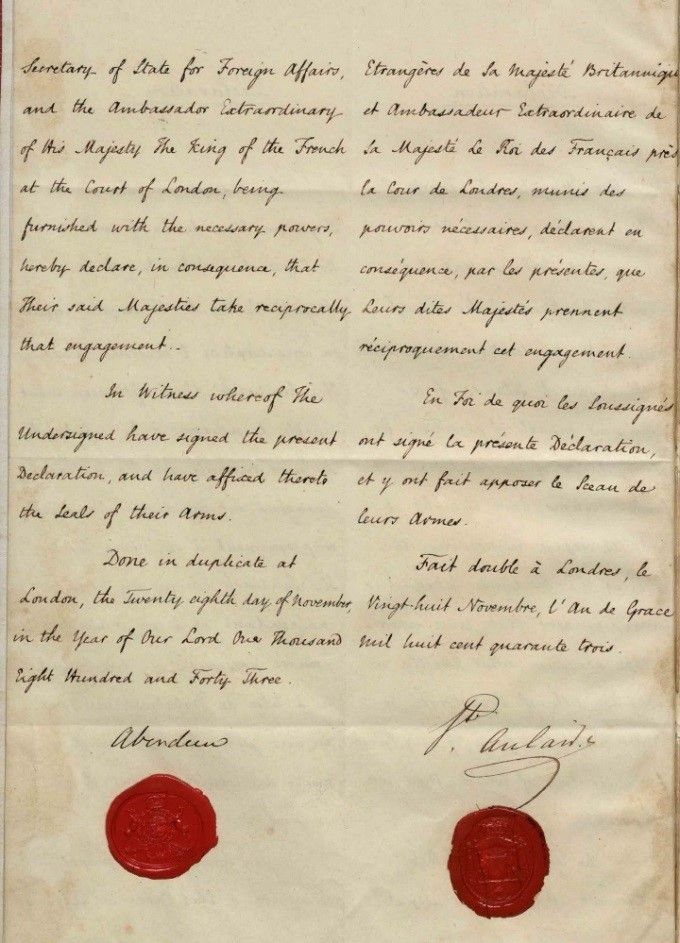Kamehameha Schools is a Native Hawaiian organization that has adopted four Cultural Principles of Hawaiian Identity that serve as a foundation for all we do at KS. One of those principles, Hoʻōla Lāhui – Revitalizing the Hawaiian People, speaks to our commitment to revitalize the Hawaiian people by providing opportunities for employees, haumāna and ʻohana to learn about and cultivate Hawaiian identity, history and culture, and the Hawaiian Experience (the totality of historical challenges and triumphs that over time continue to shape and advance the condition of the Hawaiian people).
Before the Thanksgiving holiday was celebrated in Hawaiʻi, the Hawaiian Kingdom had its own national holiday, Lā Kū‘oko‘a (Independence Day), observed annually on November 28. It was on that day in 1843, Hawai‘i was formally recognized as an independent nation by the powerful countries of Britain and France.
In 1840, Mr. Richard Charlton, first British ambassador to Hawai‘i, falsely claimed ownership of land and sparked a chain of events which ultimately led to the forced cession and restoration of the Hawaiian Kingdom three years later. The effects of this land claim also lingered within the Hawaiian judicial system and prompted Kauikeaouli (Kamehameha III) to enact the Māhele of 1848, forever changing the Kingdom’s system of land tenure.
By late 1842, Charlton’s land claim remained unresolved and Kauikeaouli decided to send two emissaries, William Richards and Timoteo Ha‘alilio, to negotiate formal treaties recognizing Hawai‘i’s sovereignty from various nations.
In February of 1843, Captain Lord George Paulet of Britain arrived in Hawaiʻi to investigate Charlton’s claim, he quickly and illegally seized the Hawaiian Kingdom. Although Ha‘alilio and Richards had already obtained US President Tyler and Congress’ verbal assurance of Hawai‘i’s independence, this informal acknowledgement was not yet enough to overturn Paulet’s actions.
Over the next five months, Great Britain worked with the Hawaiian Kingdom to rectify the situation, and on July 31, 1843, British Admiral Richard Thomas returned the Hawaiian Kingdom to Kauikeaouli. That day became known as Lā Ho‘iho‘i Ea, another Hawaiian national holiday marking the ho‘iho‘i (restoration, return) of Hawai‘i’s ea (sovereignty).
During that entire time, Ha‘alilio and Richards continued their successful mission in Europe with the aid of Sir George Simpson of the Hudson Bay Company. They stayed even beyond the events of July 31 specifically to witness the formal treaty signing between Britain and France that recognized the sovereignty of the Hawaiian Kingdom. This day was November 28, 1843, Lā Kū‘oko‘a – Independence Day.
The first version of the Hawaiian coat of arms was created at this time to aid the ambassadors in their official mission. While in London, Ha‘alilio submitted a design he made to a professional engraver to have him create the formal seal, which after a few changes was officially adopted in 1845.
The Hawaiian Kingdom’s national independence was recognized by 16 world nations between 1843 and 1885. International treaty relationships were established with such countries as Austria-Hungary, Belgium, France, Germany, Great Britain, Italy, Japan, Netherlands, Russia, Spain, Sweden and Norway, the Swiss Confederation, and the United States of America.
STRATEGIC PLAN 2020
SP2020 is a five-year strategic plan that will guide Kamehameha Schools from 2015 to 2020. The plan marks a starting point toward KS’ Vision 2040, which envisions success for all Native Hawaiian learners.
This story on Hawaiian Independence Day addresses Goal 3 of SP2020 which calls for KS to cultivate a Native Hawaiian identity within its learners. It also supports Action 5 of Kamehameha’s Ten Actions for fiscal year 2017, calling for KS to integrate cultural principles system-wide.

Original Anglo-French Declaration from the United Kingdom Archives. 1843.

Page two of the original Anglo-French Declaration from the United Kingdom Archives. 1843.

King Kamehameha III (Kauikeaouli)

The King’s private Secretary, Timoteo Ha‘alilio and the King’s long-time advisor, William Richards, were chosen to be Hawai‘i’s emissaries seeking recognition of Hawaiʻi’s independence. Mr. Haʻalilio and Mr. Richards departed to the United States via Mexico on July 8, 1842.
Related stories
TAGS
history,
16-17action5,
hookahua,
hawaiian history,
kauikeaouli,
lā kū 'oko ',
hawnculture,
sp2020
CATEGORIES
Kaipuolono Article, Newsroom, Department News
Print with photos
Print text only










